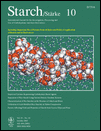Characterization and Utilization of Acid-modified Rice Starches for Use in Pharmaceutical Tablet Compression
Abstract
Acid modified, agglomerated starches offer specific advantages as fillers in production of pharmaceutical tablets. Spray drying can improve processing of tablet mixtures significantly. In order to investigate prerequisites in utilization of rice starch, non-waxy and waxy types were partially hydrolyzed in 6% (w/v) HCl solution at room temperature for varied length of time to obtain rice starches with increased crystallinity (so-called crystalline rice starches). Scanning electron micrographs of native and highly crystalline starches were used to study the morphological changes and to suggest the mode of acid attack during hydrolysis. Exo-corrosion distributed over the surface of acid-modified waxy rice starch (AWRS) was observed after 192 h of hydrolysis. In contrast, the surface of acid-modified rice starch (ARS) remained unchanged at 192 h of acid hydrolysis. The amylose content and the median particle size (diameter) were reduced with increasing hydrolysis time. It was found by X-ray diffraction that the relative crystallinity of acid-modified starches at >95% relative humidity was clearly increased with prolonged hydrolysis time.
For studying tablet properties spherical agglomerates of the native and acid modified starches were directly compressed at 4 kN to obtain tablets. Crushing strength and disintegration time of tablets increased with relative crystallinity. In contrast, tablet friability was reduced. Concerning tablet functionality, the crystalline starches were positioned in overlapping ranges between the common commercial tablet fillers (microcrystalline cellulose, pregelatinized starch and lactose, respectively).




